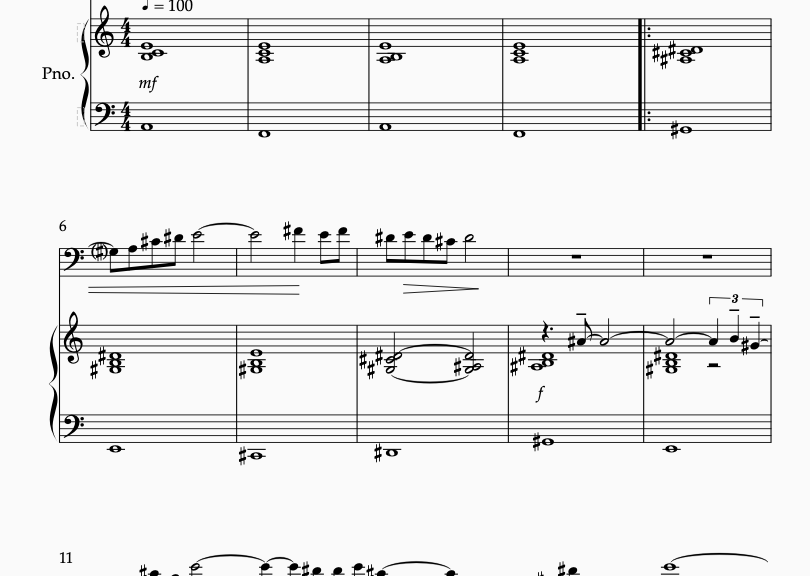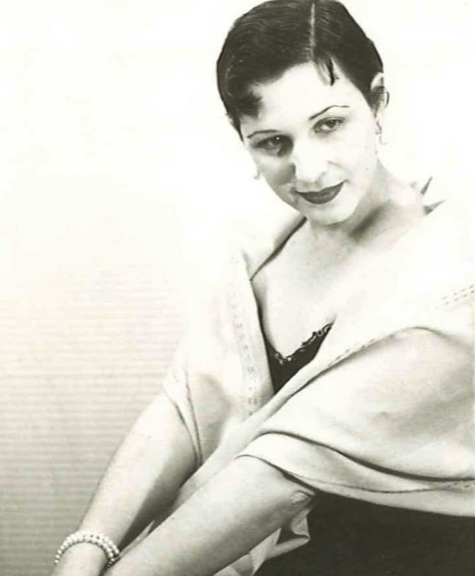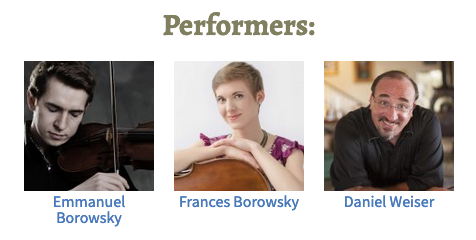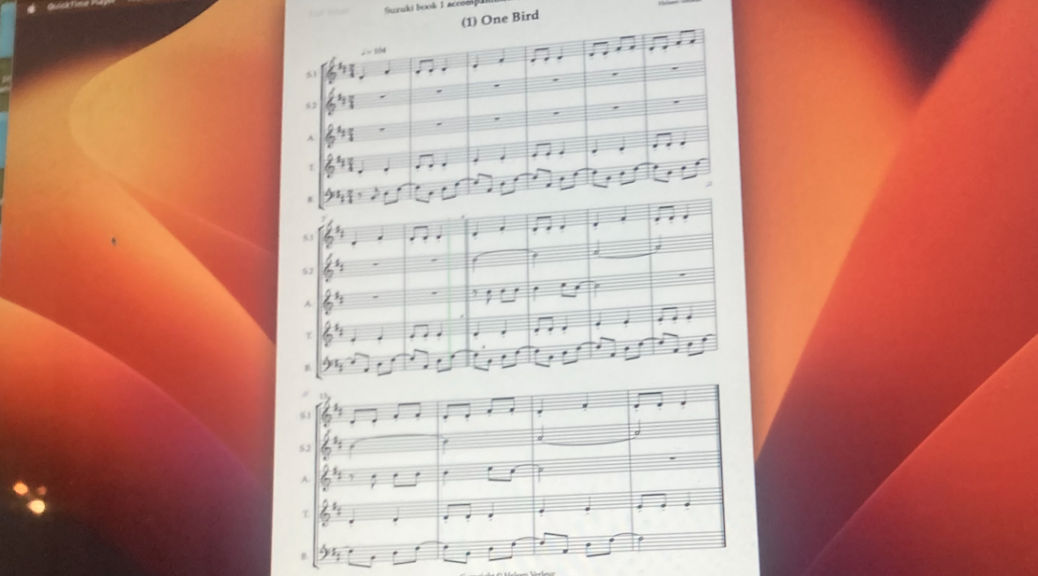Categoriearchief: English
Noten lezen (2) Note reading
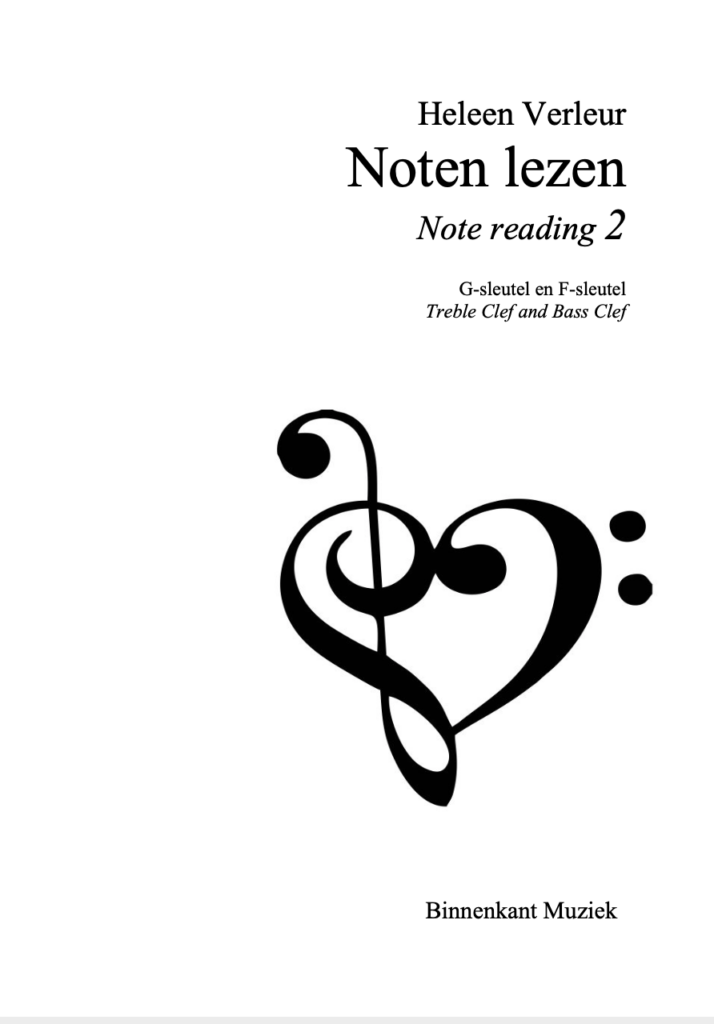
Inleiding
In boek 1 zaten voornamelijk noten tussen de lijnen (“even” noten).
Dit was om de tertsen goed te leren onderscheiden. Vanaf nu gaan we hierop voortbouwen. De tertsen worden “ingekleurd” met “oneven” lijn-noten.
In dit tweede boekje komen de noten door de lijn in de vorm van toonladdertjes aan bod. De even noten vormen hierbij het raamwerk, en geven steun bij het lezen van de oneven noten. Het is als bij een kleurplaat: de even noten zijn de afbeelding, het inkleuren wordt gedaan met de oneven noten. Het gaat om de snelle herkenning van de noten, het moet uiteindelijk volkomen geautomatiseerd zijn.
Bij de meeste oefeningen heb ik de stokken weggelaten, zodat de leerling zich helemaal kan focussen op de hoogte. Ritme wordt een ander boekje!
Aan het eind van het boek is nog een apart hoofdstuk over meer intervallen. Dit kan desgewenst ook eerder worden doorgenomen
Introduction
In book 1 there were mainly “even” notes (between the lines), to learn to recognize the interval third. The beginning pianist is invited to discover a larger range of the keyboard. One doesn’t always count from the middle C or one specific note. The result is a better orientation.
In this follow-up booklet 2 also the notes on the lines (“odd” notes) will be used in short pieces with scale patterns. The even notes form the
Framework making the reading of the odd notes easier. It’s like a colouring picture: first there is a drawing, then the drawing is colored with odd notes. It’s all about fast recognition of the notes, and the more automatically this goes, the better!
I have omitted the sticks for most exercises, so that the student can fully focus on the height. Rhythm becomes a new book!
In the appendix there is a separate chapter on more intervals. This can also be discussed earlier if desired.
Heleen Verleur, april 2024
My student of 2,5 with his parents
He only started very recently. He is doing such a great job! And so do his parents, who are so involved.
Waking Up
Dit stuk was eerder oorspronkelijk voor baritonsax & piano geschreven (speciaal voor Arthur Heuwekemeijer!) maar ter gelegenheid van de boekpresentatie van Jan, heb ik het ook gearrangeerd voor fagot & piano.
Maple Leaf Rag
Some time ago I arranged this Maple Leaf Rag I for five (right) hands on piano. It is big fun (and possible!) to play it on one piano, but if you have the luxury to use multiple pianos, this is also possible.
Tips for playing on one piano:
- alle stand at the piano, with your right sight towards the piano
- before you start, check that everyone has enough space
- enjoy & laugh!
Other pieces I arranged for five hands on one piano:
Anitra’s Tanz/Grieg
Die Forelle/Schubert
William Tell/Rossini
Habanera/Bizet
Eine kleine Nachtmusik/Mozart
Train/Verleur: Intercity (movie)
“Life ain’t so bad”
This cheerful Boogie was written by my former teacher Fania Chapiro in 1951. Deze vrolijke Boogie schreef mijn oud-lerares Fania Chapiro in 1951.
Meer over Fania Chapiro is hier te lezen.
Chapiro’s handwritten version was converted into Sibelius notation by me for a concert. Frankly, I like her handwriting better, but the Sibelius version is a little easier to read, especially in the busier passages. This piece again reminded me very much of a CD recording with her in a little church in Kortenhoef, where I was allowed to turn her pages. Although there was almost only music of Mozart recorded, Fania had to relax in the break by indeed playing some Boogie-Woogie. She liked that and could do it well.
Chapiro’s handgeschreven versie van “Life ain’t so bad” | Donemus is voor een concert door mij omgezet in Sibelius notatie. Eerlijk gezegd vind ik haar handschrift mooier, maar de Sibelius versie is iets makkelijker te lezen, vooral in de drukkere passages. Ik moest bij dit stuk weer heel erg denken aan een cd-opname met haar in een kerkje in Kortenhoef, waar ik haar bladzijden mocht omslaan. Hoewel er bijna alleen muziek van Mozart werd opgenomen, moest Fania zich in de pauze even ontspannen door inderdaad wat Boogie-Woogie te spelen. Dat vond ze leuk en kon ze ook goed.
You can hear the mp3 of the piece below. It is a recording of a live performance on Sunday, January 21, 2024 in Huis van de Wijk Lydia (Roelof Hartplein, Amsterdam) with APK (Amsterdams Pianodocenten Kollektief) https://mafpiano.nl/apk during the Benefit concert for Ukraine: nl4ua.org
Je kunt de mp3 van het stuk hieronder horen. Het is een registratie van een live uitvoering op zondag 21 januari 2024 in Huis van de Wijk Lydia (Roelof Hartplein, Amsterdam) met APK (Amsterdams Pianodocenten Kollektief) https://mafpiano.nl/apk tijdens het benefietconcert voor Oekraïne: nl4ua.org
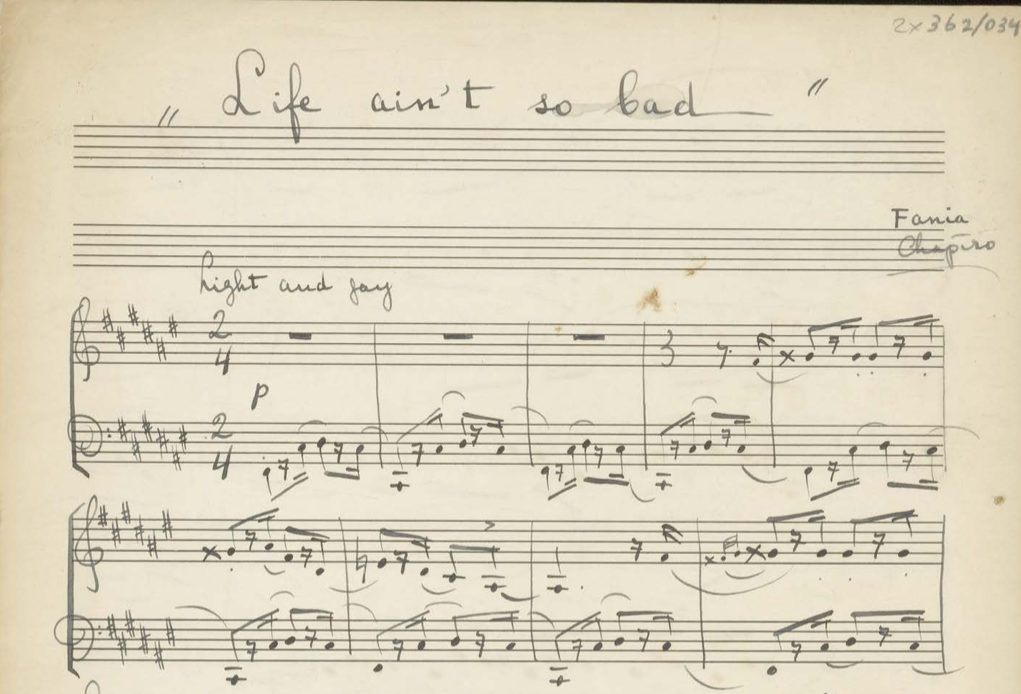
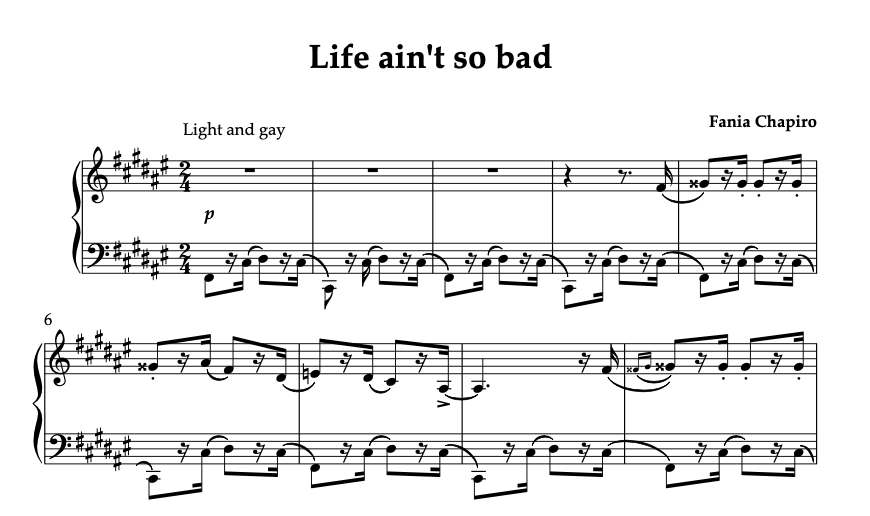
Benefit Concert Ukraine
On January 21 2024, a benefit concert for Ukraine took place by the Amsterdam Piano Teachers Kollektief. It was sold out soon, but APK is planning a second concert later in the year.
Op zondag 21 januari 2024 vond er een benefietconcert voor Oekraïne plaats door het Amsterdams Pianodocenten Kollektief. Het was al snel uitverkocht, maar APK is bezig met de planning van een tweede concert later in het jaar.
Opname ‘Plyve Kacha’ | Het eendje zwemt
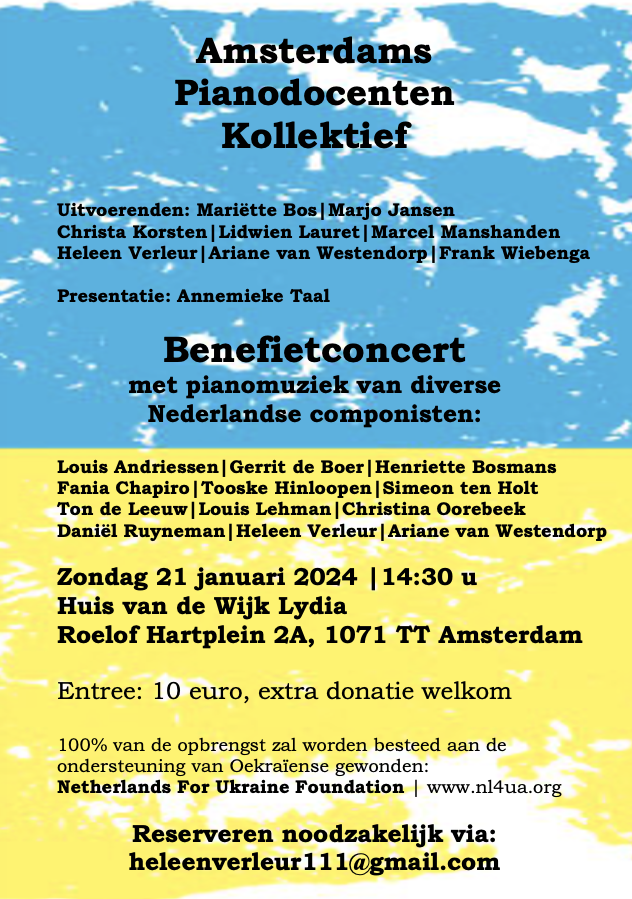
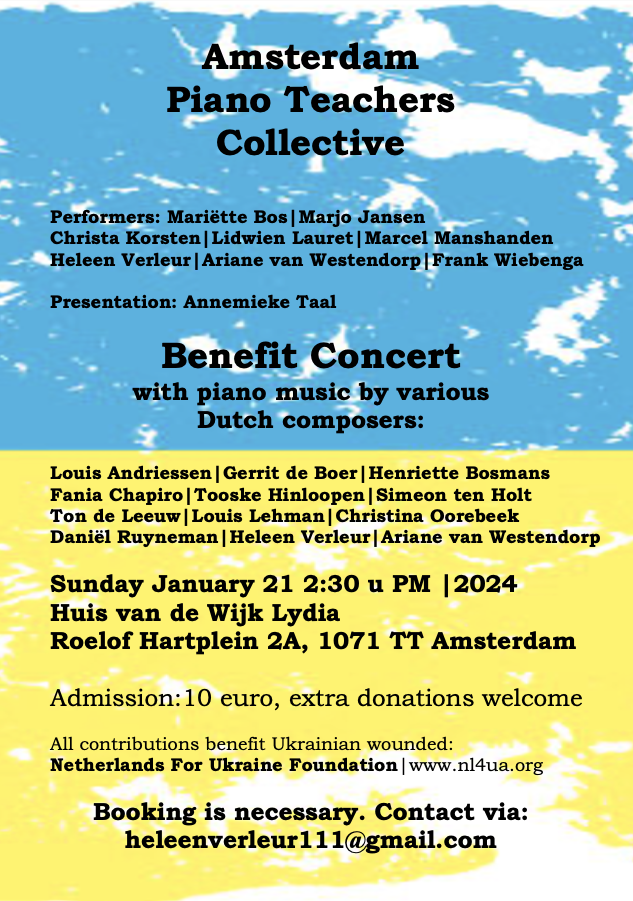
Vier handen, vijf handen, zes handen
Een greep uit vier- vijf- en zeshandige pianostukken Verleur:
2013 Onderweg | Eigen uitgave op aanvraag (Lopend & Rennend )
2015 Waves piano 6 handen | Webshop Edition MatchingArts
2017 Piano Animals 4- en 6 handen
Youtube Piano Animals | Review Anne Ku | Review Nadia Lasserson
Published at Donemus: Piano Animals 4- and 6 hands
2018 Berceuse pour ceux qui ne veulent pas encore dormir | Slaapliedje voor wie nog niet wil gaan slapen | Webshop Edition MatchingArts
2019 Circus voor 6 handen Youtube: Circus (hier met 16 handen)
Eigen uitgave op aanvraag.
2021 Twaalf dansen voor piano 4-handig (inclusief improvisatie)
Eigen uitgave op aanvraag. | Recensie Christo Lelie in Piano Bulletin ’21
2021 When Bach met Lavignac and Smetana, Long Long Ago
2023 Intercity voor 5 rechterhanden | Gratis beschikbaar voor educatieve doeleinden. Uitleg & partituur ‘Intercity’
Ooit koos ik voor het instrument piano omdat het al helemaal “af” is. Je hebt niemand nodig om je te begeleiden. Tegenwoordig vind ik ook het samenspel heerlijk, maar ik zie ook aan mijn leerlingen dat ze het vaak heel gezellig vinden om met anderen samen te werken. Bovendien is dit superleerzaam, want je merkt dat iemand gewoon doorgaat als jij even hapert, en dan is het aan jou om die persoon weer op te sporen. Je wordt er handig van en het geeft je zelfvertrouwen dat als er iets mis gaat, je het weer kunt oplossen.
Mijn collega Hens Vlam-Verwaaijen, ons wel bekend van haar vele mooie en speelse stukken voor jongeren, is hierbij een voorbeeld geweest. Zij heeft ook zowel solo- als duostukken geschreven. Haar serie ‘Bridge over de Classics’ wordt nog altijd veel gebruikt:
Youtube kanaal Hens Vlam-Verwaaijen
Zelf ben ik ook steeds aan het experimenteren met meerdere handen op 1, 2, 3, 4 of zelfs 5 piano’s. Bij het Groninger Piano Festival speelden we zelfs met 16 pianisten op op 5 piano’s! Onlangs, op de Dag van de Componist, én op het afscheid (pensioen) van viooldocent Harry Vogel hebben we met vijf pianisten, ieder één hand, Intercity gespeeld. Een hilarische gebeurtenis! Samenspelen is zo fun.
Recording from Baltimore
My Tango Trio, first composition ever been published (2001), has landed in the US. Daniel Weiser (piano) played it, together with wonderful violin player Emmanuel Borowsky and cello player Frances Borowsky. There is a beautiful recording that was sent to me by Daniel. I think these musicians really understood the little jokes in the piece.
Before performance the 2nd movement, Dan mailed me to ask: “What is this little theme that is used there, it sounds so familiar!” I almost forgot about that, but is was a famous Scottish melody (he tells about it in the Introduction below).
Dan Wiser: “More people need to know about this very fun piece of Dutch contemporary composer Heleen Verleur that includes the blues, tango, and other popular idioms.”
The Tango Trio can be ordered at Broekmans & Van Poppel
Internationale (online) blokfluit conferentie
Vanmiddag was ik online te gast bij een internationale conferentie voor blokfluit. Het was bijzonder zoveel mensen van over de hele wereld in één oogopslag op het scherm bij elkaar te zien. Er waren zelfs twee Iraanse vrouwen bij, maar ook Brazilië was vertegenwoordigd, Spanje, Amerika, Engeland, Australië, en nog veel meer.
Alweer enige tijd geleden schreef ik 33 arrangementen voor blokfluit ensemble. Dit boek zal dit jaar worden uitgegeven. Het zijn 33 korte stukken, want het zijn stukken voor de beginnende blokfluitist: sopraanblokfluitboek 1. Ik vond het een superleuke uitdaging hier iets heel moois mee te doen! Als je bijvoorbeeld kijkt naar de melodie van hieronder, dan zie je dat bij de 1e sopraan de stem heel simpel is (namelijk slechts 2 tonen).
Maar door de vier andere partijen klinkt het ineens wel anders:
Spannend moment, vanmiddag: blokfluitdocent Jaap Delver vertelde over de stukken, maar liet er ook een heleboel horen via zijn ‘shared screen’. Je kon zeg maar met de bladmuziek meekijken en luisteren. Hoe bijzonder is het om je eigen muziek terug te horen, wetende dat in allerlei landen tot zelfs in Iran, mensen hierop reageerden! Nog sterker: ik keek de toehoorders recht in het gezicht en zag steeds meer lachende snoetjes! De muzikale grapjes bleken gelukkig over te komen! Zoals van ‘Altijd is kortjakje ziek’ heb ik een tango gemaakt:
Iedereen was gemute, maar er kwamen hartverwarmende reacties in de chat (ik schrijf er hier een paar anoniem). Trouwens opvallend veel jonge aanwezigen die ook enthousiast waren.
Ik moet er nog even van bijkomen!
- Heleen Verleur! – THANK YOU SO MUCH! (Brazilië)
- All of them are wonderful and full of fantasy! Thank you very much!
- These are fabulous arrangements! Thank you so much for composing them!
- Love the different styles and interesting chords (many applauding hands)
- Love them!! Unique and Beautiful arrangements!
- Yes. these are great! How exciting, let’s hope they can be published soon 🙂
Hierbij een derde voorbeeld: Hongaarse dans.
Ps ik zal via mijn website berichten wanneer de arrangementen gepubliceerd worden.
